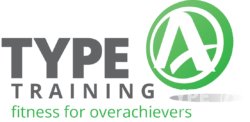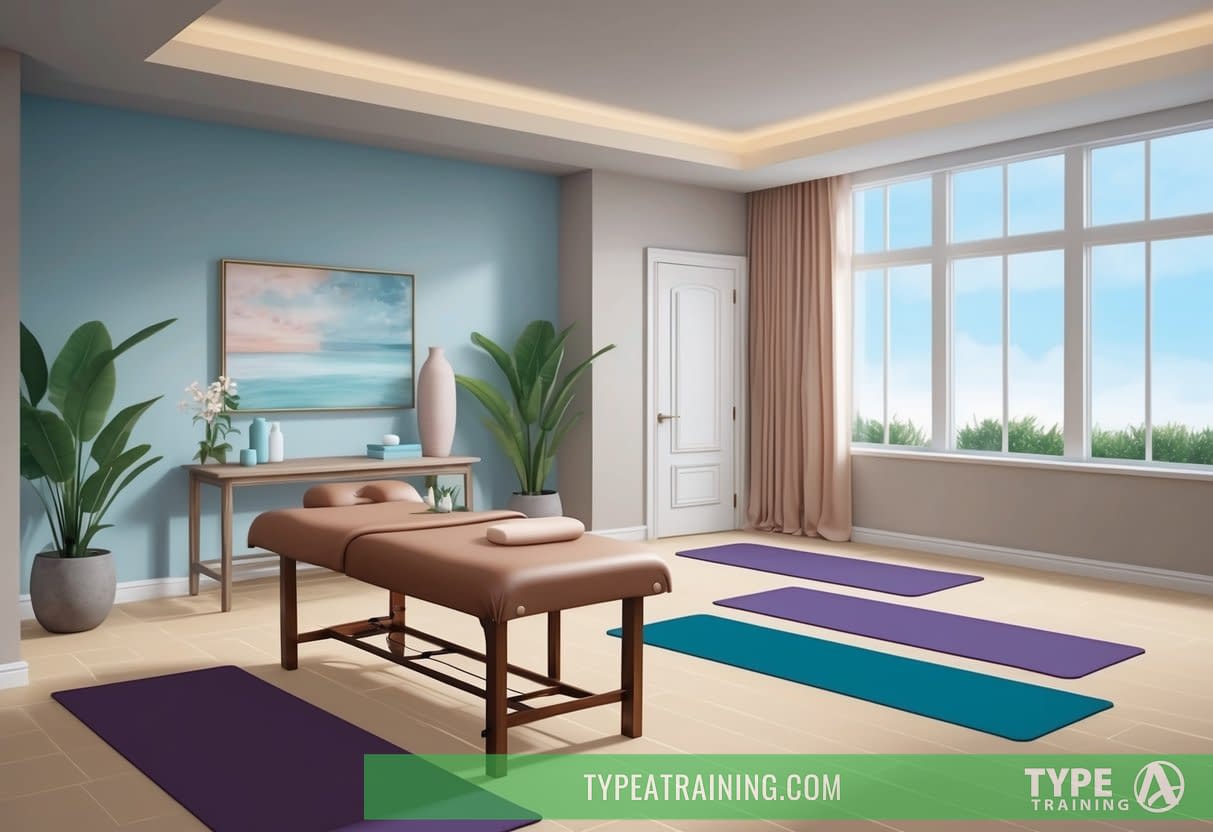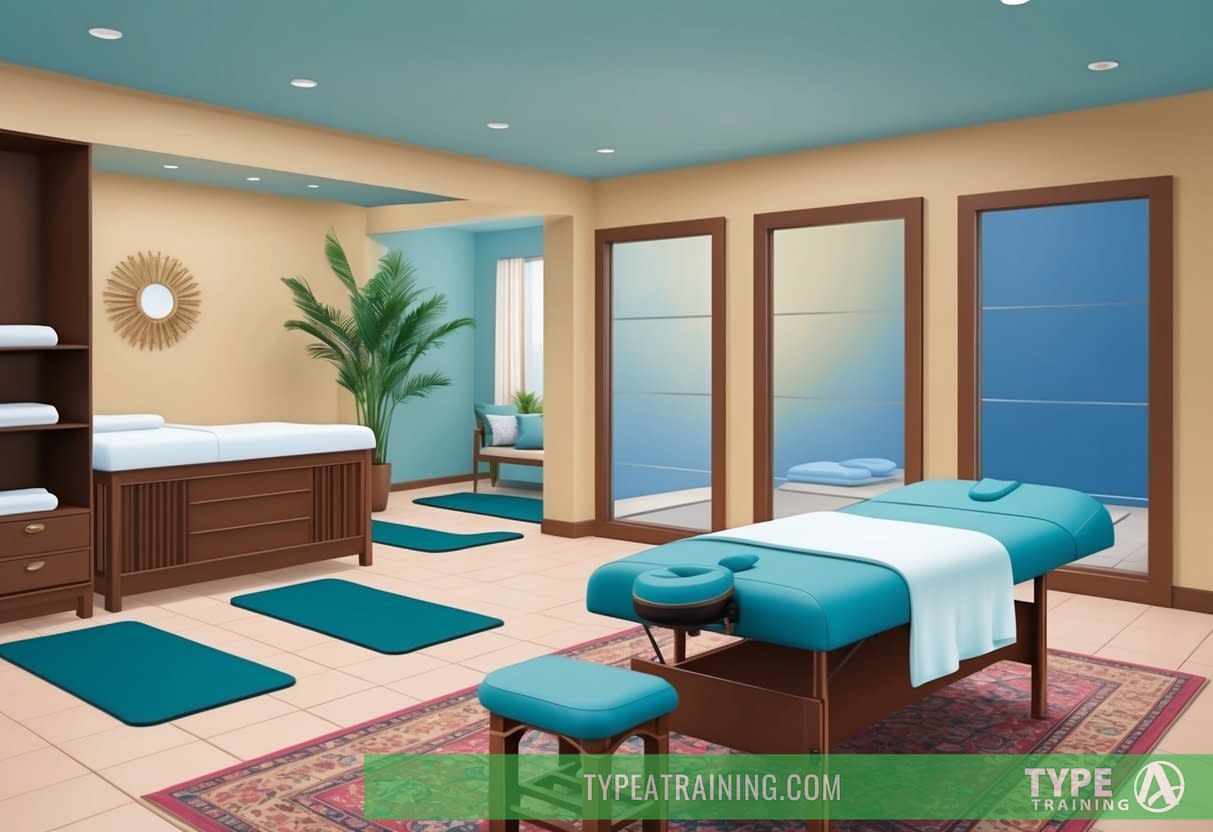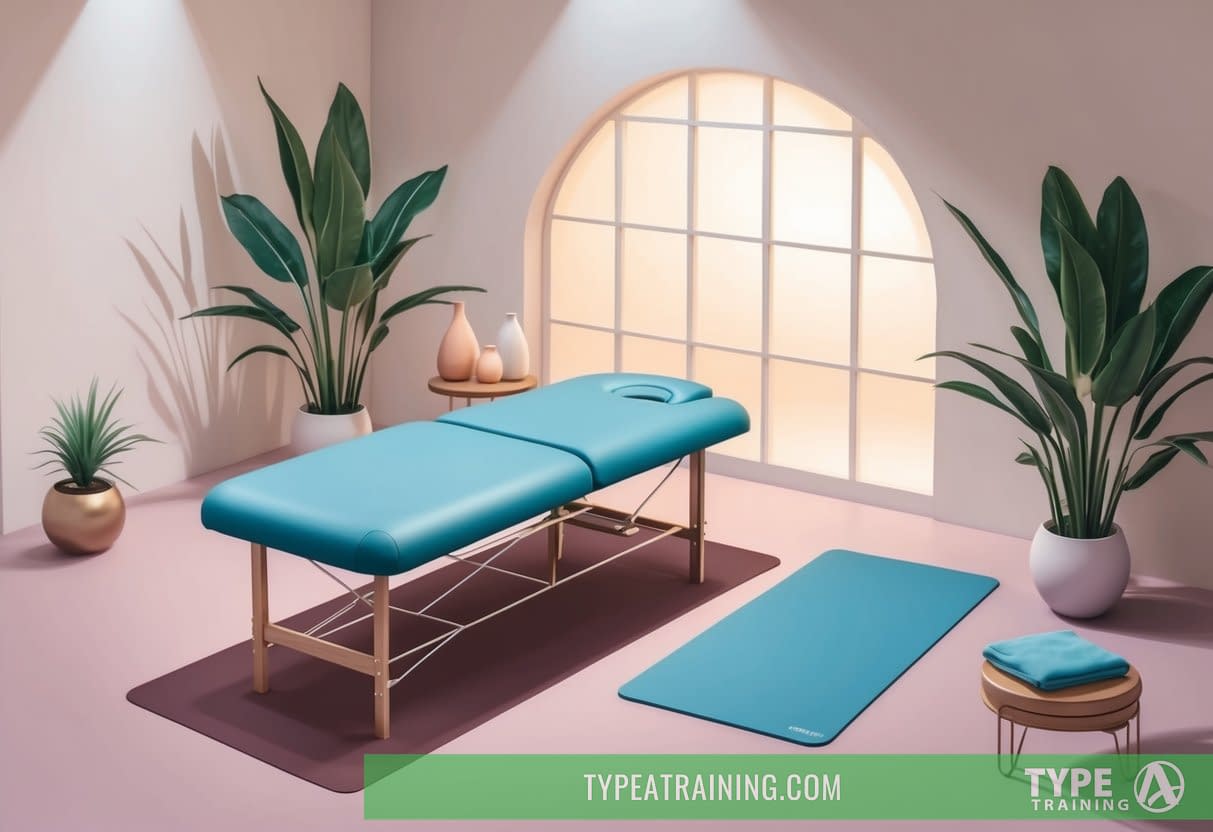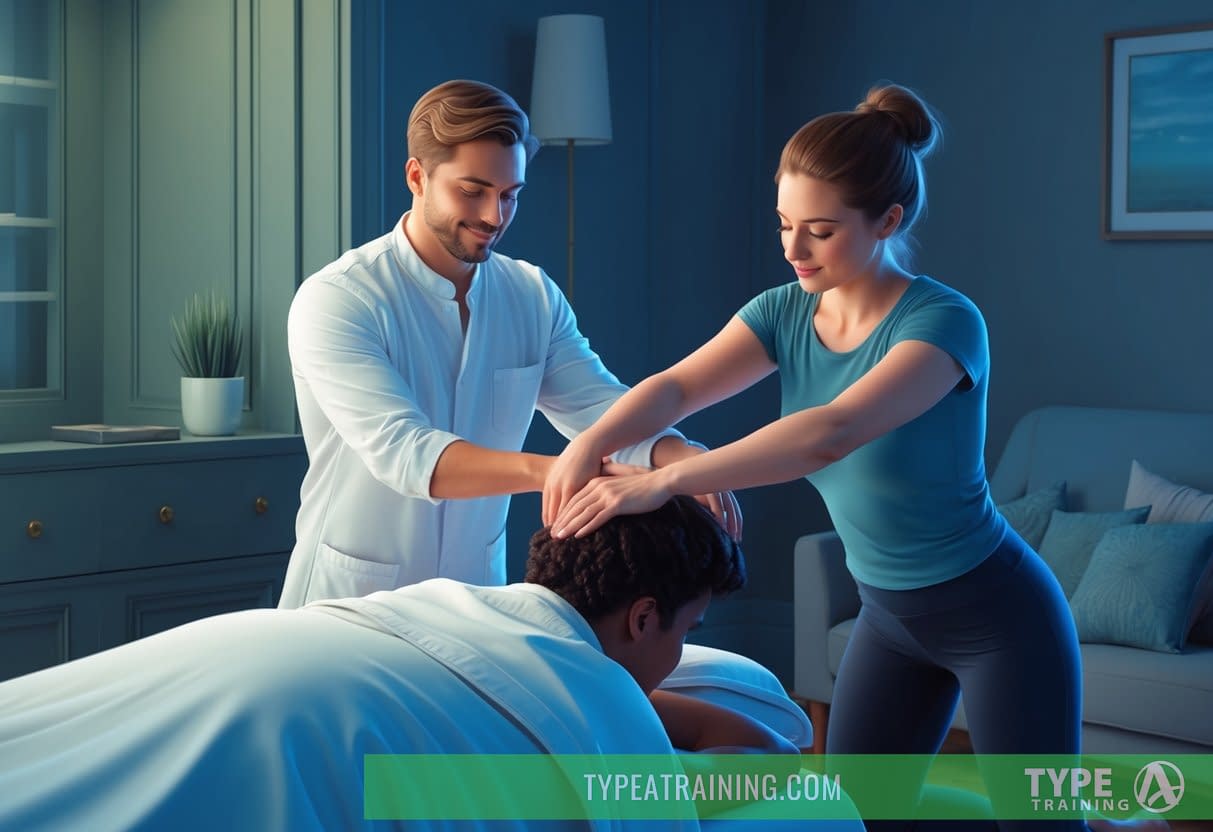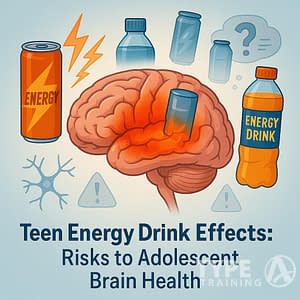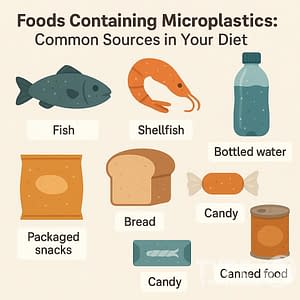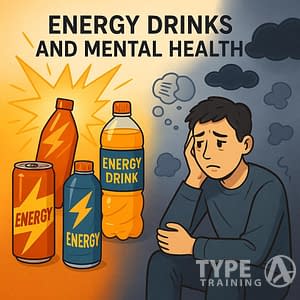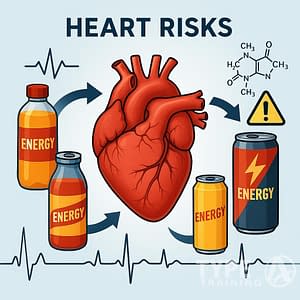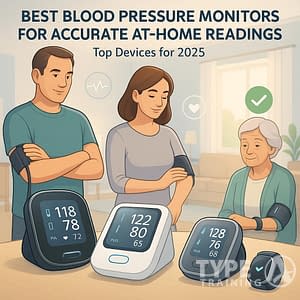Massage Therapy vs Assisted Stretching are popular techniques for improving physical well-being and alleviating muscle tension. Both approaches offer unique benefits, but they differ in their methods and outcomes. Understanding the differences can help you choose between Massage Therapy VS Assisted Stretching.
Massage therapy focuses on manipulating soft tissues to promote relaxation and reduce pain. On the other hand, assisted stretching involves a practitioner guiding you through stretches to enhance flexibility and range of motion.
When considering Massage Therapy VS Assisted Stretching, it’s essential to recognize the unique advantages each method offers for muscle recovery and flexibility enhancement.
Choosing between massage therapy and assisted stretching depends on your specific goals and needs.
Popular posts:
Massage can be ideal for those seeking deep relaxation and stress relief. Assisted stretching, on the other hand, may be more suitable if you’re looking to increase flexibility, prevent injuries, or improve athletic performance. Some people find that combining both techniques provides a comprehensive approach to body maintenance and recovery.
Ultimately, your choice between Massage Therapy VS Assisted Stretching should align with your body’s needs and wellness goals.
Key Takeaways
- Massage therapy targets relaxation and pain relief through soft tissue manipulation
- Massage Therapy VS Assisted Stretching provides distinct paths to achieving physical wellness.
- Assisted stretching improves flexibility and range of motion with guided movements
- Combining both techniques can offer a well-rounded approach to physical wellness
Overview of Massage Therapy

Massage Therapy VS Assisted Stretching are both excellent options for improving physical health.
Massage therapy is a hands-on technique that manipulates your body’s soft tissues. It aims to promote relaxation, reduce muscle tension, and alleviate soreness.
During a session, a trained massage therapist applies pressure to your muscles, tendons, and ligaments. This can help improve circulation and release knots or trigger points in your tissues.
Massage offers several potential benefits:
- Pain relief
- Reduced muscle tension
- Improved flexibility
- Enhanced relaxation
- Increased sense of well-being
There are various types of massage, including:
- Swedish massage
- Deep tissue massage
- Sports massage
- Trigger point therapy
Massage can stimulate the release of endorphins, your body’s natural pain-relieving chemicals. This may contribute to an improved mood and reduced stress levels.
Many people report feeling more relaxed and experiencing less muscle soreness after treatments.
Massage can be an effective tool for recovery, especially after intense physical activity. It may help reduce post-exercise muscle tension and promote faster healing.
While some claim massage releases toxins, scientific evidence for this is limited. However, the increased circulation from massage can support your body’s natural processes.
Overview of Assisted Stretching

Assisted stretching is a hands-on technique where a trained professional helps you increase your flexibility and range of motion. This method involves a therapist guiding your body through various stretches, supporting and applying gentle pressure to enhance the stretch’s effectiveness.
Understanding the differences between Massage Therapy VS Assisted Stretching is crucial for maximizing your recovery and flexibility.
You’ll typically lie on a massage table or mat during an assisted stretching session. The therapist will move your limbs and apply pressure to specific muscle groups, helping you achieve deeper stretches than you might on your own.
Assisted stretching incorporates several techniques:
- Static stretching: Holding a stretch for a set time
- Dynamic stretching: Moving through a stretch
- Proprioceptive Neuromuscular Facilitation (PNF): Alternating contraction and relaxation
- Fascial Stretch Therapy: Targeting connective tissue
These methods can help improve your flexibility, reduce muscle tension, and enhance your overall mobility. Many people find assisted stretching beneficial for both athletic performance and daily activities.
Assisted stretching sessions are often one-on-one, allowing for personalized attention to your specific needs.
While similar to massage in some ways, assisted stretching is more interactive. You’ll often engage your muscles during the process, working with the therapist to maximize the benefits of each stretch.
Comparative Benefits
In comparing Massage Therapy VS Assisted Stretching, consider what fits your individual lifestyle and wellness needs.
Massage therapy and assisted stretching offer unique advantages for your physical well-being.
The exploration of Massage Therapy VS Assisted Stretching reveals a spectrum of benefits that can cater to various physical goals.
Massage excels at improving circulation and blood flow. It can help relieve muscle tension and pain while promoting overall relaxation and stress reduction.
Assisted stretching focuses on enhancing flexibility, mobility, and range of motion. You’ll likely experience improved posture and muscle balance through guided stretching techniques.
Both methods contribute to injury prevention and overall wellness. However, assisted stretching takes a more active approach, requiring your participation and feedback during sessions.
Massage provides a passive, deeply relaxing experience. It’s particularly effective for addressing specific areas of muscle tightness or pain.
Comparing Massage Therapy VS Assisted Stretching can help you make informed decisions about your health routine.
Assisted stretching offers a more holistic approach to body maintenance. It can help correct imbalances and improve your body’s overall functionality.
Here’s a quick comparison of key benefits:
| Benefit | Massage Therapy | Assisted Stretching |
|---|---|---|
| Circulation | ✓✓✓ | ✓✓ |
| Flexibility | ✓ | ✓✓✓ |
| Pain Relief | ✓✓✓ | ✓✓ |
| Injury Prevention | ✓✓ | ✓✓✓ |
| Active Participation | – | ✓✓✓ |
Massage Therapy VS Assisted Stretching: A Comparative Analysis
Massage therapy and assisted stretching employ distinct techniques to address muscle tension and improve flexibility.
It’s important to weigh the benefits of Massage Therapy VS Assisted Stretching based on your physical needs.
Massage focuses on manipulating soft tissues through various strokes and pressures.
Common massage modalities include Swedish, deep tissue, and trigger point therapy. These techniques aim to relax muscles, increase circulation, and release knots or adhesions in connective tissue.
Assisted stretching incorporates several approaches to enhance flexibility and range of motion. Static stretching involves holding a position for 15-30 seconds, while dynamic stretching uses controlled movements.
Proprioceptive Neuromuscular Facilitation (PNF) is an advanced stretching technique. It combines passive and active movements to improve muscle elasticity and joint mobility.
In assisted stretching sessions, you’ll actively participate by engaging specific muscle groups. Your therapist will guide you through stretches, providing support and resistance as needed.
Both massage and stretching can target trigger points – areas of tight muscle fibers that cause pain. Massage uses direct pressure, while stretching aims to lengthen the affected muscles.
Stretch therapy often incorporates elements of active and passive stretching. You may perform some movements independently, while your therapist assists with others to achieve deeper stretches.
Applications and Use-Cases
Massage therapy and assisted stretching have distinct applications in promoting physical health and recovery.
You can benefit from massage therapy when dealing with muscle soreness or soft tissue injuries. It’s commonly offered at spas, wellness centers, and some gyms.
Assisted stretching is often utilized for injury prevention and improving flexibility. You’ll find this service at specialized stretch centers, some chiropractor offices, and athletic training facilities. Companies like StretchZone and Stretch*d have popularized this approach.
For athletes, both techniques play important roles in training and recovery. Massage can help alleviate post-workout muscle soreness, while assisted stretching may enhance performance and reduce injury risk.
Incorporating elements of both Massage Therapy VS Assisted Stretching can lead to enhanced recovery and performance.
Here’s a quick comparison of typical use-cases:
| Massage Therapy | Assisted Stretching |
|---|---|
| Relaxation | Flexibility improvement |
| Pain relief | Range of motion increase |
| Stress reduction | Athletic performance enhancement |
| Scar tissue treatment | Posture correction |
Choosing Between Therapies
Weighing the pros and cons of Massage Therapy VS Assisted Stretching can significantly impact your recovery strategy.
Deciding between massage therapy and assisted stretching depends on your specific needs and goals.
Consider your current physical condition and what you hope to achieve.
If you’re dealing with muscle tension and seeking relaxation, massage therapy may be the better choice.
Massage Therapy VS Assisted Stretching offers different approaches that can cater to your specific needs.
It can help alleviate stress and promote overall wellness.
For those aiming to improve flexibility and range of motion, assisted stretching could be more beneficial.
This therapy can enhance your body’s mobility and potentially prevent future injuries.
Your personal preference plays a crucial role.
Some individuals find massage more enjoyable, while others prefer the interactive nature of assisted stretching.
Consider your schedule and lifestyle.
Massage therapy often requires less active participation, making it suitable for those seeking passive relaxation.
Assisted stretching, however, involves more engagement and can be seen as an extension of your self-care routine.
Both therapies can contribute to your quality of life.
Massage may provide immediate relief from tension, while assisted stretching can offer longer-term benefits for flexibility.
Many people find a combination of both therapies to be most effective for their overall wellness.
Consult with professionals to create a plan that best suits your needs.
Complementary Nature of Both Approaches
Massage therapy and assisted stretching offer unique benefits that work well together. When combined, they create a comprehensive approach to body care and wellness.
Massage helps improve circulation and promotes deep muscle relaxation. This can prepare your body for more effective stretching afterwards.
Assisted stretching enhances flexibility and range of motion. It also helps correct muscle imbalances that may have developed over time.
Together, these techniques support faster recovery from physical activities or injuries.
Combining Massage Therapy VS Assisted Stretching can enhance overall outcomes for physical health and wellness.
You’ll likely notice improved posture and reduced muscle tension.
The combination addresses both immediate comfort and long-term mobility goals.
Massage soothes sore muscles, while stretching helps prevent future discomfort.
For optimal results, consider alternating between massage and stretching sessions.
This allows you to experience the full spectrum of benefits from both approaches.
Remember, your body’s needs may vary. Listen to your body and adjust the frequency of each treatment accordingly.
By embracing both massage and assisted stretching, you’re investing in your overall wellness.
This holistic approach can lead to better physical performance and daily comfort.
Additional Considerations
When choosing between massage therapy and assisted stretching, consider the duration of benefits.
Massage effects often last a few days, while stretching can improve flexibility for longer periods.
Massage generally provides deeper muscle work, targeting specific areas of tension.
It may help release toxins and break down scar tissue more effectively than stretching alone.
Assisted stretching focuses on lengthening muscle fibers and fascia.
This can be particularly beneficial for those with tight muscles or limited range of motion.
You might find foam rollers useful as a complement to both treatments.
They offer a self-administered method to target muscle knots and improve flexibility between sessions.
Consider your goals and preferences.
If you enjoy hands-on treatment and relaxation, massage may be ideal.
If you prefer active participation and want to improve flexibility, assisted stretching could be your best choice.
Both techniques can be combined with other modalities like fascial stretch therapy or myofascial release (MFR) for enhanced results.
Discuss these options with your practitioner to create a tailored plan for your needs.
Remember, consistency is key.
Regular sessions of either treatment will yield the best long-term results for your muscular health and overall well-being.
Frequently Asked Questions
Both Massage Therapy VS Assisted Stretching are excellent choices for enhancing your physical health.
Massage therapy and assisted stretching offer distinct approaches to improving physical wellness. Each method has unique benefits and applications depending on individual needs and goals.
What are the different benefits of Massage Therapy VS Assisted Stretching compared to standard techniques?
Massage therapy focuses on relaxing muscles and reducing tension through manual manipulation.
It can improve circulation, alleviate pain, and promote overall relaxation.
Assisted stretching targets flexibility and range of motion.
It helps lengthen muscles, improve posture, and enhance athletic performance.
How does assisted stretching differ from traditional massage techniques in treating sciatica?
Assisted stretching for sciatica involves guided movements to target specific muscle groups.
It aims to relieve pressure on the sciatic nerve and improve flexibility in the lower back and legs.
Traditional massage for sciatica uses hands-on techniques to reduce muscle tension.
It can help alleviate pain and improve blood flow to affected areas.
Can combining massage therapy and assisted stretching enhance overall flexibility and muscle relief?
Combining these techniques can provide comprehensive benefits.
Massage therapy relaxes muscles and prepares them for stretching.
Understanding the benefits of Massage Therapy VS Assisted Stretching is key to improving your overall wellness.
Assisted stretching then helps improve flexibility and range of motion.
This combination can lead to better overall muscle health and mobility.
Why might someone choose assisted stretching at a Stretch Lab over a conventional massage?
Stretch Labs offer specialized stretching services with trained professionals.
Choosing between these modalities often comes down to personal preference for either Massage Therapy VS Assisted Stretching.
You actively participate in the stretching process, providing feedback and engaging muscles.
This approach can lead to more targeted flexibility improvements and may appeal to those seeking an interactive wellness experience.
What qualifications should a practitioner have to perform assisted stretching, and are they similar to those of a massage therapist?
Assisted stretching practitioners often have certifications in flexibility training or related fields.
They should understand anatomy, biomechanics, and proper stretching techniques.
Massage therapy and assisted stretching are two distinct techniques, often compared in the context of Massage Therapy VS Assisted Stretching.
While some skills overlap, the qualifications are generally distinct.
In what situations might massage therapy be preferred over assisted stretching and vice versa?
Massage therapy is often preferred for relaxation and stress relief. It’s also chosen for addressing specific muscle tension or pain.
It’s beneficial for those seeking a passive, soothing experience.
Many find that combining elements of Massage Therapy VS Assisted Stretching leads to superior results.
Assisted stretching may be chosen for improving flexibility, range of motion, and athletic performance. It’s ideal for those wanting an active role in their physical wellness routine.
